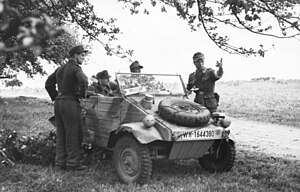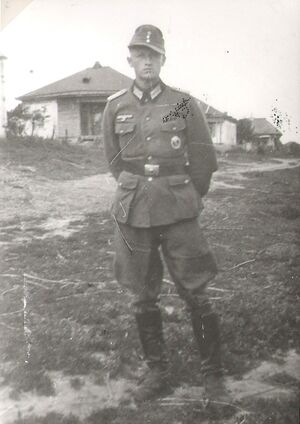Mai 1943
| GEO INFO | ||||
|---|---|---|---|---|
| Sagorodnoje | ||||
| OKW situation map 1943/Mai | ||||
Our battalion is transferred from Petrovskaya to Sagorodnoye. The village lies directly on the Donets. So we are back in our old familiar area, as we are now just a little north[1] of the section our division had occupied in the first Russian mission.
If you want to get from Petrovskaya to Sagorodnoye, you have to climb a high plateau. The treeless plateau bears extensive pastures and collective farm fields. After a one-hour walk, the plateau slopes more or less gently towards the river and then drops in a twenty to fifty-metre high escarpment to the Donets lowland. On a less steep slope lies Sagarodnoye. The upper houses are still on the plateau, while the lower ones are already on the river, which here flows close to the foot of the western slope.
So the village lies on the steep western bank of the Donez valley, and from here a wide view opens out over the Donez lowlands kilometres wide, densely forested, flat and in places marshy.

The village, where the battalion staff is also located, is the centre of our battalion's defensive section. We are high above the Donets lowland and can overlook the huge wide valley. But it is densely wooded and opaque. The Ivan is down in the woods, but he can overlook the whole village on the bare slope sloping down to the valley. That's why our food trucks coming forward from Petrovskaya can only ever appear in the evening. Only individual pedestrians can dare to cross the slope during the day. One day Gawletta, Max and I wanted to go to Petrovskaya. That's where the regiment and the leaders of the 13th and 14th companies (anti-tank and infantry guns) are. It was warm and the one-hour walk was too uncomfortable for us. We therefore wanted to take the battalion car.[3] But since the Russian usually fired at worthwhile targets, we had to be careful. The VW was in a dug-out behind the commander's house. We started the engine, got in, sped up the slope hell for leather and disappeared into the shelter of a row of bushes on the back slope.
The rifle companies' positions are mainly down by the river, at the lower edge of the village at the foot of the slope. The heavy weapons of the machine gun company form a second line halfway up the slope in the middle of the village. The positions of my mortars are scattered all over the village. The circular, chest-deep holes of the firing positions are dug in the gardens behind the houses. As usual, the crews live in the houses with the Russians. Behind this second line, there is still a hint of a third line with some anti-tank gun emplacements.

I myself live in the last village street, which runs along the upper edge of the plateau (photo[4]). In the first few days I live in a small house with only a parlour and kitchen with a woman of about 30.
Soon, however, I move into the neighbouring house with my messenger. It serves as a kolkhoz storehouse, but also has a large living room with a bed, table and chair. I now spend several weeks here. After a peaceful night's sleep under the mosquito net, I get up around 8 am. After washing, I have my breakfast. My messenger has already fetched the milk from the collective farm's milk collection point. Sometimes I also get white cheese from there. After breakfast, I spread out a blanket behind the house, protected from the enemy, take a book or reading booklet and sunglasses and lie down in the hot sun in my sports shorts. Sometimes I also walk through the village, visit the BGZ[5] or my platoon quarters. It is only in the evening that I get into uniform and make my circuit of the firing positions. I sometimes come back from these walks late at night. One evening, it must have been midnight already, I turn the corner of my house when I see the young wife of the kolkhoz camp leader standing in the doorway of the neighbouring house. She is in a petticoat. It was probably too hot for her in the house and she is looking for something to cool off. I go up to her and ask if she is not too cold. Stupid question! Because it is a warm summer night. We are not standing long when I hear a noise in the living room. The man must have been awakened by my loud voice. (Idiotic to speak loudly in such a situation!) The woman has heard it too, of course. She turns abruptly and goes back into the house. She is from Vladivostok, by the way, as she once told me. Sometimes, when she sits and chats with her neighbour, my first Hasiaika, I sit down and listen to the village gossip. I don't understand most of it, though.
The battalion commander's house stands at the end of a balka that has eaten into the hillside in the middle of the village. Tunnels are now being driven into the side walls of this ravine to serve as protective bunkers for the battalion staff. Girls and women from the village are doing this work. To make the work more pleasant for them, the battalion commander keeps his radio on while the women are working.
Recently, one of the battalion messengers unexpectedly entered the commander's parlour and burst into a tender tête-à-tête between the old man and one of the working girls. The old man, by the way, cannot pass a girl without giving her a slap on the box.
Now all the houses where members of the battalion staff lie are connected by communication trenches. This work is also done by women who have to shovel from nightfall until midnight. Sometimes I think the major just thought up this work to have the girls around.
|
Editorial 1938 1939 1940 1941 1942 1943 1944 1945 1946 1947 1948 1949 Epilog Anhang |
|
January February March April May June July August September October November December Eine Art Bilanz Gedankensplitter und Betrachtungen Personen Orte Abkürzungen Stichwort-Index Organigramme Literatur Galerie:Fotos,Karten,Dokumente |
|
1. 2. 3. 4. 5. 6. 7. 8. 9. 10. 11. 12. 13. 14. 15. 16. 17. 18. 19. 20. 21. 22. 23. 24. 25. 26. 27. 28. 29. 30. 31. Erfahrungen i.d.Gefangenschaft Bemerkungen z.russ.Mentalität Träume i.d.Gefangenschaft Personen-Index Namen,Anschriften Personal I.R.477 1940–44 Übersichtskarte (Orte,Wege) Orts-Index Vormarsch-Weg Codenamen der Operationen im Sommer 1942 Mil.Rangordnung 257.Inf.Div. MG-Komp.eines Inf.Batl. Kgf.-Lagerorganisation Kriegstagebücher Allgemeines Zu einzelnen Zeitabschnitten Linkliste Rotkreuzkarte Originalmanuskript Briefe von Kompanie-Angehörigen |
- ↑ 35 km west of Tichotzki, 60 km northwest of Slavyansk
- ↑ Photo from France, 1944
- ↑ Driving without orders, private trips and the like were forbidden, not least because of fuel consumption (KTB 1.PzA, NARA T-313 Roll 48 Frame 7282365/79, Roll 58 Frame 7293861).
- ↑ The inscription "May 1943" on the photo makes it possible to date the transfer to Sagorodnoje to the beginning of May.
- ↑ unknown abbreviation; possibly Rural Community Centre or Meeting Centre? The Russian abbreviation БГЦ doesn't fit, it means biogeocenosis, a kind of ecosystem.
